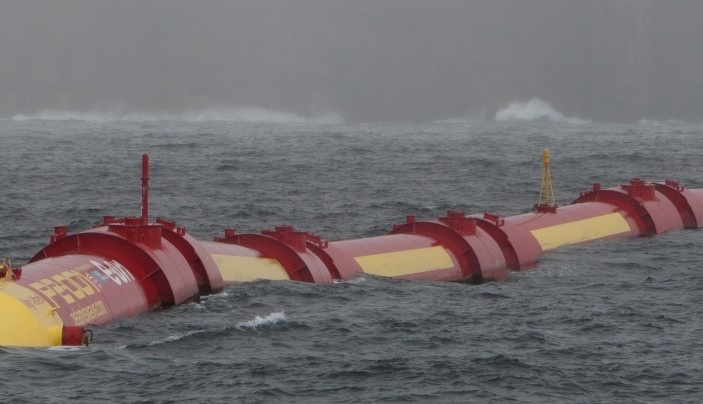Algorithm Doubles Electricity Yield From Ocean Waves
September 13, 2011
on
on

Wave power could contribute to the renewable energy portfolio in the future. At the moment the technology isn’t advanced enough to generate electricity from ocean waves commercially. But the growing interest in renewable energy has motivated several companies to invest in wave power research.
The British company Pelamis Wave Energy is currently testing its second generation Wave Energy Converter the Pelamis 2 a.k.a. P2. The Pelamis or sea snake consists of five cylindrical sections which are linked together by hinged joints. Adding up to a construction of 180m long and 4m in diameter. As a wave hits the head of the snake, the flexible parts start to move relative to one another. The motion at the hinged joints is resisted by hydraulic cylinders. High pressure oil is pumped through motors which drive generators that produce electricity.
Inside the Pelamis 2 an array of computer hardware is installed. An algorithm controls the resistance in the hydraulic cylinders. When waves are small the resistance decreases and when they are big it increases, resulting in a maximum amount of energy conversion. The application of the algorithm has doubled the electricity yield of the P2 compared to its predecessors to 750 kW.
The first Pelamis 2 was installed off the coast of Orkney, Scotland in October 2010 and is still in its testing phase. The machine was bought by the German energy utility E.ON. A second P2 was sold to ScottishPower Renewables and will be deployed off the Orkney shore later this year. The two utilities have agreed to work together and share their knowledge about how to operate a wave farm. A 30MW farm would consist of 40 P2’s covering a square mile of ocean.
Source: newscientist.com
Photo source: Pelamis Wave Power
The British company Pelamis Wave Energy is currently testing its second generation Wave Energy Converter the Pelamis 2 a.k.a. P2. The Pelamis or sea snake consists of five cylindrical sections which are linked together by hinged joints. Adding up to a construction of 180m long and 4m in diameter. As a wave hits the head of the snake, the flexible parts start to move relative to one another. The motion at the hinged joints is resisted by hydraulic cylinders. High pressure oil is pumped through motors which drive generators that produce electricity.
Inside the Pelamis 2 an array of computer hardware is installed. An algorithm controls the resistance in the hydraulic cylinders. When waves are small the resistance decreases and when they are big it increases, resulting in a maximum amount of energy conversion. The application of the algorithm has doubled the electricity yield of the P2 compared to its predecessors to 750 kW.
The first Pelamis 2 was installed off the coast of Orkney, Scotland in October 2010 and is still in its testing phase. The machine was bought by the German energy utility E.ON. A second P2 was sold to ScottishPower Renewables and will be deployed off the Orkney shore later this year. The two utilities have agreed to work together and share their knowledge about how to operate a wave farm. A 30MW farm would consist of 40 P2’s covering a square mile of ocean.
Source: newscientist.com
Photo source: Pelamis Wave Power
Read full article
Hide full article


Discussion (0 comments)